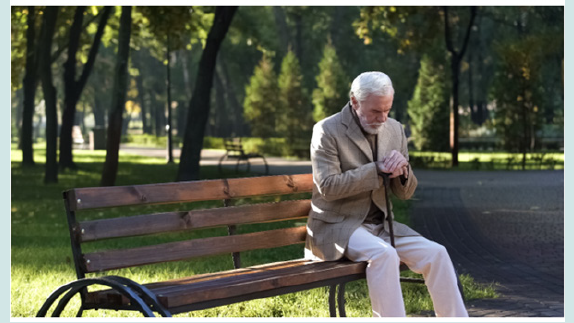
Lupine Publishers Group
Lupine Publishers
Menu
ISSN: 2641-1768
Thematic and Conceptual PaperOpen Access
Decoding Urban Loneliness: Exploring an Emerging Concept Volume 8 - Issue 2
Tigran Haas*
- KTH Royal Institute of Technology, Stockholm, Sweden
Received: July 15, 2024; Published: July 23, 2024
Corresponding author: Tigran Haas, KTH Royal Institute of Technology, Stockholm, Sweden.
DOI: 10.32474/SJPBS.2024.08.000284
Abstract
- Abstract
- Introduction
- Loneliness: Causes, Effects, and Solutions
- How to Overcome Loneliness
- The Duality of Solitude and Urban Loneliness: Longing for Belonging
- Conceptual Model of Urban Loneliness: The Duality of Solitude and Belonging
- Concepts and Relationships in Urban Loneliness
- Temporal Dimensions of Urban Loneliness
- Time Perception and Loneliness
- Time Use and Social Connectivity
- Transitional Periods and Social Disruption
- Long Term Social Isolation
- Future Orientation and Loneliness
- Addressing the Temporal Dimensions of Loneliness
- Happy City and Combating Urban Loneliness: The Bright Side of Life
- The Complexity of Achieving Happy Cities: The Shadows of Existence
- Final Contribution: Defining Urban Loneliness and Closing Thoughts
- Acknowledgement
- Conflict of Interest
- References
Urban loneliness, a multifaceted phenomenon influenced by spatial, temporal, and social dimensions, is the focus of this thematic, reflective, and conceptual paper. By synthesizing insights from urban sociology, environmental psychology, and philosophical perspectives, we aim to address urban loneliness comprehensively. We explore how strategies such as place attachment and designing meaningful, context-sensitive spaces can mitigate loneliness by fostering a sense of belonging. The role of temporal aspects, including daily routines and subjective time perception, is examined to understand their impact on social disconnection. The importance of social capital, both bonding and bridging, is highlighted. We stress the crucial role of equitable access to social infrastructure in maintaining community cohesion. Environmental stressors such as noise and overcrowding and their effects on mental health and social interactions are discussed. The paper proposes a holistic approach to urban planning incorporating narrative urbanism, temporal urbanism, inclusive design, participatory planning, and mindful urbanism. By integrating these strategies, urban planners, including the esteemed audience, can play a pivotal role in creating environments that promote social connectivity, enhance well-being, and reduce loneliness. The paper underscores the importance of a comprehensive understanding of urban loneliness, crucial for fostering resilient and vibrant urban communities that address the dual needs for social interaction and personal space. Finally, this paper proposes the ‘Happy City’ concept, advocating for urban design principles that enhance happiness and combat urban loneliness by fostering human connections, accessibility, and community engagement.
Keywords: Urban loneliness; Loneliness; Place attachment; Temporal experience; Social capital; Spatial justice; Environmental stressors; Narrative urbanism; Inclusive design; Participatory planning; Mindful urbanism
Introduction
- Abstract
- Introduction
- Loneliness: Causes, Effects, and Solutions
- How to Overcome Loneliness
- The Duality of Solitude and Urban Loneliness: Longing for Belonging
- Conceptual Model of Urban Loneliness: The Duality of Solitude and Belonging
- Concepts and Relationships in Urban Loneliness
- Temporal Dimensions of Urban Loneliness
- Time Perception and Loneliness
- Time Use and Social Connectivity
- Transitional Periods and Social Disruption
- Long Term Social Isolation
- Future Orientation and Loneliness
- Addressing the Temporal Dimensions of Loneliness
- Happy City and Combating Urban Loneliness: The Bright Side of Life
- The Complexity of Achieving Happy Cities: The Shadows of Existence
- Final Contribution: Defining Urban Loneliness and Closing Thoughts
- Acknowledgement
- Conflict of Interest
- References
In the bustling hearts of major cities, a silent epidemic of loneliness is spreading. Many urban residents feel isolated despite the lively streets and vibrant scenes of cities like Paris, New York, London, Stockholm, and Lisbon. This paradox, where people feel lonely amidst crowds, is an increasing concern in urban environments worldwide. While dense populations and hectic urban lifestyles might suggest plentiful opportunities for social interaction, the reality often contradicts this. According to research by Holt-Lunstad et al. [1], lacking social connections can be as harmful to one’s health as smoking 15 cigarettes a day. The constant busyness of city life often leads to superficial interactions, leaving little room for deeper, more meaningful relationships. Research by Cacioppo, Hawkley, and Thisted [2] demonstrates that perceived social isolation can significantly contribute to depressive symptoms, highlighting the profound impact of loneliness on mental health.
Social psychology sheds light on the roots of urban isolation. A report by The Lancet [3] notes that urban residents frequently experience social overload, leading them to withdraw and avoid further social interaction-a behavior known as ‘social withdrawal.’ This behavior perpetuates a cycle of isolation, where individuals feel alone despite being surrounded by countless potential connections. The juxtaposition of a crowded urban life and personal loneliness represents a modern paradox that demands urgent attention. By understanding the causes of urban loneliness and implementing solutions that foster genuine social connections, we can begin to combat this epidemic, fostering a greater sense of community and belonging in our cities. Urban loneliness (Figure 1) is a complex and multifaceted phenomenon influenced by spatial, temporal, and social dimensions. Understanding and addressing urban loneliness requires a comprehensive approach incorporating insights from urban sociology, environmental psychology, and philosophical perspectives on space and place. The concept of place attachment, where emotional bonds to specific locations play a crucial role, is fundamental in understanding how urban design can proactively mitigate loneliness [4-6]. Creating meaningful, context-sensitive spaces that foster a sense of belonging and support human activities and social interactions is essential for combating loneliness in urban settings [7]. However, transient spaces that fail to foster meaningful social connections contribute significantly to feelings of alienation [8]. Temporal aspects, including daily routines and lifecycle stages, also play a crucial role in urban loneliness, with disruptions in these rhythms leading to disconnection [9,10]. Furthermore, subjective temporal experiences, as explored by Wittmann [11], illustrate how the perception of time influences social interactions and overall well-being (Figure 1).
Figure 1: Urban Loneliness: A portrait of a depressed, lonely young African American man sitting on the balcony with an urban view in the evening. Photo Royalty Free Unsplash License and courtesy of Bigstock and Big Stock Photo. HallPoint, September 14, 2022.

From an urban sociology perspective, social capital-both bonding and bridging-is vital in addressing urban loneliness. Bonding social capital refers to strong ties with close family and friends, while bridging social capital involves looser connections with a broader range of people, fostering inclusivity and diversity [12,13]. The equitable distribution of social infrastructure and the prevention of gentrification are critical to maintaining community cohesion and reducing loneliness [14,15]. Inequitable access to social spaces and amenities often exacerbates feelings of isolation, making spatial justice a central concern in urban planning [14]. Environmental psychology provides additional insights into the impact of urban stressors, such as noise and overcrowding, on mental health and social interactions. This underscores the need for a holistic approach to urban planning [16,17] that considers all factors. Behavioral settings and affordances in the urban environment determine the opportunities for social interaction, where well-designed public spaces can significantly enhance social connectivity [18,19]. Effective interventions require a comprehensive approach integrating narrative urbanism, temporal urbanism, inclusive design, participatory planning, and mindful urbanism. Narrative urbanism involves integrating the history and stories of communities into the urban fabric to create a sense of belonging [20,21]. Temporal urbanism focuses on designing for the rhythms of urban life, with spaces that adapt to different times of day and year [10,11]. Inclusive design ensures spaces are accessible and welcoming to all demographics, promoting social equity [22,23]. Participatory planning engages residents in the design process, fostering a sense of belonging and attachment [24,25]. Mindful urbanism incorporates principles of mindfulness and mental well-being into urban design, addressing environmental stressors and supporting the mental health of urban residents [26,27]. By integrating these diverse perspectives and approaches, urban planners and designers can develop more holistic and empathetic strategies to address the complex nature of urban loneliness. This comprehensive understanding is crucial for creating urban environments that foster social connectivity, enhance well-being, and mitigate the adverse effects of loneliness.
Loneliness: Causes, Effects, and Solutions
- Abstract
- Introduction
- Loneliness: Causes, Effects, and Solutions
- How to Overcome Loneliness
- The Duality of Solitude and Urban Loneliness: Longing for Belonging
- Conceptual Model of Urban Loneliness: The Duality of Solitude and Belonging
- Concepts and Relationships in Urban Loneliness
- Temporal Dimensions of Urban Loneliness
- Time Perception and Loneliness
- Time Use and Social Connectivity
- Transitional Periods and Social Disruption
- Long Term Social Isolation
- Future Orientation and Loneliness
- Addressing the Temporal Dimensions of Loneliness
- Happy City and Combating Urban Loneliness: The Bright Side of Life
- The Complexity of Achieving Happy Cities: The Shadows of Existence
- Final Contribution: Defining Urban Loneliness and Closing Thoughts
- Acknowledgement
- Conflict of Interest
- References
Loneliness is when an individual feels a lack of close connection with others. This emotional emptiness is uncomfortable and can leave a person feeling dissatisfied, anxious, and sad [28]. Over time, it can severely affect one’s overall functioning and diminish their quality of life. Many young individuals have recently sought support due to loneliness [29]. Loneliness differs from boredom. While boredom might occasionally mimic loneliness, it is generally viewed as an environmental issue. Increasing social interactions and engaging in more social activities can alleviate boredom, but it doesn’t address the core issue of loneliness, as the feeling persists internally [30]. This state can have a prolonged impact on a person’s overall functioning, significantly reducing their quality of life.
Who Experiences Loneliness?
Loneliness affects people of all ages and backgrounds, including children, women, and men, rich and poor, and even those who appear socially surrounded and popular [31]. Loneliness doesn’t have a set timeframe. For some, it can be a short-term issue quickly resolved, while for others, it can last a lifetime. This is particularly true for individuals who expect problems to resolve themselves or believe in the saying “this too shall pass” [32]. Loneliness is found in small communities (villages, small towns) and large cities, with people in urban areas often being more alienated and thus lonelier [33]. Even if a person is employed, financially secure, living in a big city, and has numerous superficial contacts, both personal and through phone calls, they can still feel lonely. The issue of loneliness is not solved by the quantity of acquaintances but by the quality of relationships [34].
Why Does Loneliness Happen?
Loneliness occurs because humans need to form emotional bonds with others, sharing thoughts and feelings. Living in a community is natural for human beings. Individual development primarily happens within the family unit, where establishing one’s own family and having children brings the greatest satisfaction [35]. There is minimal fulfilment a person can achieve independently of others. Any form of isolation, whether physical (such as solitary confinement) or the perception of not fitting into one’s environment, is a very distressing experience for a person [36]. Loneliness has undoubtedly accompanied humanity since its inception. Early humans’ harsh conditions and survival struggles left little room for such feelings. Furthermore, due to significant life threats (illnesses, natural disasters, wars, poverty), people banded together to survive these challenges more easily. As human societies evolved, life became more manageable, but people drifted apart [37].
How to Overcome Loneliness
- Abstract
- Introduction
- Loneliness: Causes, Effects, and Solutions
- How to Overcome Loneliness
- The Duality of Solitude and Urban Loneliness: Longing for Belonging
- Conceptual Model of Urban Loneliness: The Duality of Solitude and Belonging
- Concepts and Relationships in Urban Loneliness
- Temporal Dimensions of Urban Loneliness
- Time Perception and Loneliness
- Time Use and Social Connectivity
- Transitional Periods and Social Disruption
- Long Term Social Isolation
- Future Orientation and Loneliness
- Addressing the Temporal Dimensions of Loneliness
- Happy City and Combating Urban Loneliness: The Bright Side of Life
- The Complexity of Achieving Happy Cities: The Shadows of Existence
- Final Contribution: Defining Urban Loneliness and Closing Thoughts
- Acknowledgement
- Conflict of Interest
- References
Loneliness is a disruptive state that affects a person’s daily life. However, individuals often fail to recognize the true nature of their problem, deny their loneliness, or defend themselves using various mechanisms [38]. Many lonely people remain passive and do nothing to solve their problems or unconsciously create a false image of themselves, portraying themselves as busy or unapproachable due to a lack of time for others. Consequently, their surroundings may not recognize this as a defense mechanism. People who emphasize their independence and claim not to need anyone are deceiving themselves and others if this isn’t how they feel. Thus, the first step in combating loneliness (as with many other issues) is for the individual to admit they are lonely. This is challenging because acknowledging a problem is often seen as a sign of weakness or failure, which is not true [39]. Recognizing and accepting loneliness allows individuals to explore ways to address it. Adopting new attitudes, values, and beliefs and redefining feelings are essential to overcoming loneliness. Developing meaningful relationships and engaging in activities that promote genuine connections can significantly help alleviate feelings of loneliness. The quality of these interactions is crucial in combating the sense of isolation [40].
The Duality of Solitude and Urban Loneliness: Longing for Belonging
- Abstract
- Introduction
- Loneliness: Causes, Effects, and Solutions
- How to Overcome Loneliness
- The Duality of Solitude and Urban Loneliness: Longing for Belonging
- Conceptual Model of Urban Loneliness: The Duality of Solitude and Belonging
- Concepts and Relationships in Urban Loneliness
- Temporal Dimensions of Urban Loneliness
- Time Perception and Loneliness
- Time Use and Social Connectivity
- Transitional Periods and Social Disruption
- Long Term Social Isolation
- Future Orientation and Loneliness
- Addressing the Temporal Dimensions of Loneliness
- Happy City and Combating Urban Loneliness: The Bright Side of Life
- The Complexity of Achieving Happy Cities: The Shadows of Existence
- Final Contribution: Defining Urban Loneliness and Closing Thoughts
- Acknowledgement
- Conflict of Interest
- References
Loneliness is a subjective feeling of isolation, social disconnection, or emotional detachment from others. It often manifests as a distressing experience associated with not having one’s social needs met through interactions with others. Loneliness can occur even in the presence of others when connections are not meaningful or fulfilling. This state is generally viewed negatively and is associated with a range of adverse mental health outcomes, including depression, anxiety, and decreased life satisfaction [31]. Chronic loneliness can lead to significant psychological stress and physical health issues, such as cardiovascular problems and weakened immune function [36,41]. Solitude, on the other hand, is being alone without feeling lonely. It is often sought out intentionally and can be a source of relaxation, self-reflection, and regeneration. Solitude temporarily allows individuals to disconnect from the social world and focus on their inner thoughts, feelings, and personal experiences [42]. Unlike loneliness, solitude is usually considered a positive and enriching experience that contributes to personal growth, creativity, and emotional well-being [43]. Research indicates solitude enhances creativity, provides selfdiscovery opportunities, and promotes psychological resilience [44]. Solitude, isolation, alienation, and seclusion all describe being alone but differ in their connotations and emotional impacts. Solitude is often a chosen state and can be positive, while isolation stresses detachment, often due to external factors or personal choice, implying a physical or mental separation from others [28]. Alienation involves estrangement and a loss of connection with one’s environment or society, often despite being surrounded by others [45]. Seclusion implies a deliberate withdrawal from social contact, making access to oneself difficult for others [20]. Each of these states can contribute to feelings of loneliness, but they are distinct in their causes and implications. Urban loneliness (Figure 2) is a complex issue influenced by various factors, including social isolation, high population density, fragmented communities, urban design and infrastructure, digital communication, socioeconomic factors, and mental health [12,17]. Social isolation arises from a lack of meaningful social interactions, often due to long working hours, transient populations, or limited social support systems [41]. High population density in cities can lead to anonymity, making it challenging to build personal connections [46]. Fragmented communities result from diverse populations with different backgrounds and interests, leading to a lack of commonality and belonging [25] (Figure 2).
Figure 2: A lonely city person sitting in a train looking out the window, Sofia Bulgaria. Photo by Georgi Kalaydzhiev, October 31, 2021. Royalti Free Unsplash License and courtesy of Mr. Georgi Kalaydzhiev.

Urban planning design and infrastructure significantly impact social interactions. Sprawling layouts, lack of public spaces, and poor walkability can discourage social encounters and inhibit opportunities for connection [22]. While digital communication platforms offer new ways to stay connected, excessive reliance on virtual interactions can create a sense of isolation from faceto- face social interactions [47]. Socioeconomic disparities, such as income inequality and gentrification, can exacerbate feelings of loneliness, particularly among marginalized communities [14]. Mental health issues associated with urban loneliness include depression, anxiety, and low self-esteem, which can perpetuate a cycle of social isolation and loneliness [31]. Effective interventions require a comprehensive approach integrating narrative urbanism, temporal urbanism, inclusive design, participatory planning, and mindful urbanism. Narrative urbanism involves integrating the history and stories of communities into the urban fabric to create a sense of belonging [20,21]. Temporal urbanism focuses on designing for the rhythms of urban life, with spaces that adapt to different times of day and year [10,11]. Inclusive design ensures spaces are accessible and welcoming to all demographics, promoting social equity [22,23]. Participatory planning engages residents in the design process, fostering a sense of belonging and attachment [24]. Mindful urbanism incorporates principles of mindfulness and mental well-being into urban design, addressing environmental stressors and supporting the mental health of urban residents [26,27]. By recognizing and addressing the dual needs for social interaction and personal space, urban planners can create environments that enhance overall well-being, reduce feelings of loneliness, and provide opportunities for rejuvenating solitude. This comprehensive understanding is crucial for creating urban environments that foster social connectivity, enhance well-being, and mitigate the adverse effects of loneliness. Addressing urban loneliness and promoting positive experiences of solitude through urbanism, city planning, and urban design involves creating environments that encourage social interaction, community engagement, and personal well-being. This integrated approach can transform cities into spaces where individuals experience a sense of belonging and opportunities for peaceful solitude. Addressing urban loneliness requires thoughtful urban design, facilitating social interactions, and community engagement. Studies have shown that the design, use, and accessibility of public spaces significantly impact feelings of isolation among urban residents [48].
Conceptual Model of Urban Loneliness: The Duality of Solitude and Belonging
- Abstract
- Introduction
- Loneliness: Causes, Effects, and Solutions
- How to Overcome Loneliness
- The Duality of Solitude and Urban Loneliness: Longing for Belonging
- Conceptual Model of Urban Loneliness: The Duality of Solitude and Belonging
- Concepts and Relationships in Urban Loneliness
- Temporal Dimensions of Urban Loneliness
- Time Perception and Loneliness
- Time Use and Social Connectivity
- Transitional Periods and Social Disruption
- Long Term Social Isolation
- Future Orientation and Loneliness
- Addressing the Temporal Dimensions of Loneliness
- Happy City and Combating Urban Loneliness: The Bright Side of Life
- The Complexity of Achieving Happy Cities: The Shadows of Existence
- Final Contribution: Defining Urban Loneliness and Closing Thoughts
- Acknowledgement
- Conflict of Interest
- References
Urban loneliness is a profound and multifaceted phenomenon that requires a comprehensive understanding of its underlying dimensions and their interplay. This conceptual model delves into the philosophical, sociological, and psychological aspects of urban loneliness, exploring how these dimensions interact and shape the experiences of individuals in urban environments. Existential Space is crucial in how individuals perceive and experience urban environments daily. The phenomenology of place, a concept deeply rooted in the works of urban geographers, philosophers, and place theorists like Edward Relph [4] and Yi-Fu Tuan [5], emphasizes the subjective and emotional connections individuals form with their surroundings. These connections foster a sense of place integral to one’s identity and well-being. Spaces that resonate emotionally with residents can mitigate loneliness by providing a sense of belonging and continuity. Temporal Experience is another vital dimension, capturing the cyclical patterns of social life in urban settings. The concept of temporal rhythms, including work leisure cycles and seasonal changes, affects how people interact with their environment and each other. Mikhail Bakhtin’s idea of chronotopes highlights how time and space intrinsically shape human experiences [9]. Narratives of time, shaped by personal and collective histories, further influence one’s sense of belonging and loneliness. Urban design must recognize and incorporate these temporal rhythms to create spaces that foster social cohesion and continuity. Social Capital is a cornerstone of urban sociology, highlighting the importance of social networks and relationships in mitigating loneliness. Robert Putnam’s distinction between bonding and bridging social capital illustrates how strong ties with close family and friends (bonding) and looser connections with a broader range of people (bridging) both play essential roles in fostering inclusivity and diversity [12]. Urban environments that facilitate these connections can help combat loneliness by promoting a sense of community and belonging. Spatial Justice addresses the equitable distribution of social spaces and resources, ensuring that all urban residents can access amenities that foster social interactions. The works of David Harvey [14] and others emphasize the importance of preventing gentrification and displacement, which can disrupt community cohesion and exacerbate loneliness. Spatial justice involves designing urban environments that are inclusive and equitable, protecting existing communities, and promoting social well-being. Environmental Stressors such as noise, pollution, and overcrowding significantly impact mental health and social interactions. Research in environmental psychology, such as that by Gary Evans [16], underscores the adverse effects of these stressors on psychological well-being. Urban design should prioritize green spaces, noise reduction, and pollution control to create environments conducive to social interactions and mental health. Behavioral Settings focus on how the physical environment supports or inhibits social interactions. James Gibson’s concept of affordances [18] highlights how the design of spaces can either facilitate or hinder social engagement. Balancing public and private realms, respecting personal space, and encouraging communal living are crucial for fostering social connectivity. Humancentric design principles prioritizing mental health and well-being are essential in addressing urban loneliness.
Concepts and Relationships in Urban Loneliness
- Abstract
- Introduction
- Loneliness: Causes, Effects, and Solutions
- How to Overcome Loneliness
- The Duality of Solitude and Urban Loneliness: Longing for Belonging
- Conceptual Model of Urban Loneliness: The Duality of Solitude and Belonging
- Concepts and Relationships in Urban Loneliness
- Temporal Dimensions of Urban Loneliness
- Time Perception and Loneliness
- Time Use and Social Connectivity
- Transitional Periods and Social Disruption
- Long Term Social Isolation
- Future Orientation and Loneliness
- Addressing the Temporal Dimensions of Loneliness
- Happy City and Combating Urban Loneliness: The Bright Side of Life
- The Complexity of Achieving Happy Cities: The Shadows of Existence
- Final Contribution: Defining Urban Loneliness and Closing Thoughts
- Acknowledgement
- Conflict of Interest
- References
Urban loneliness is intricately tied to the emotional bond between individuals and specific locations, known as place attachment. This sense of belonging is pivotal for combating loneliness and fostering community ties. In contrast, transient spaces, often called nonplaces, lack significant social ties and contribute to feelings of rootlessness and alienation. By integrating narrative spaces that tell the story of the community, urban design can foster a sense of continuity and belonging, thereby mitigating the adverse effects of urban loneliness. Creating spaces that resonate emotionally with residents, reflecting the community’s history and culture, can transform impersonal urban landscapes into meaningful places of connection. Rituals and routines are crucial in fostering social cohesion within urban settings. Daily, weekly, and seasonal rituals create a rhythm that enhances social interactions and community ties. These practices embed a sense of regularity and expectation within the urban environment, strengthening communal bonds. However, disruptions in these rhythms can lead to temporal displacement and feelings of disconnection. Recognizing and incorporating these rituals into urban design can promote a sense of belonging and reduce loneliness, ensuring residents feel anchored and engaged with their community. For instance, designing public spaces facilitating community events, markets, and seasonal celebrations can help maintain these vital social rhythms. A sophisticated approach to urban design involves integrating philosophical, sociological, and psychological frameworks. Philosophically, urban spaces should resonate emotionally with residents, evoking a sense of history, memory, and identity. This involves creating narrative spaces that reflect the temporal rhythms of urban life. From an urban sociology perspective, environments should facilitate strong and weak social ties, ensuring equitable distribution of resources and protecting communities from displacement. Spatial justice is critical here, as ensuring fair access to social spaces and amenities can significantly impact social cohesion and community resilience. Environmental psychology emphasizes mitigating urban stressors through human-centric designs prioritizing mental health and well-being. Environmental stressors such as noise, pollution, and overcrowding can have detrimental effects on mental health, contributing to feelings of loneliness and social isolation. Designers can create environments that support social interactions and overall well-being by incorporating green spaces, noise reduction measures, and pollution control into urban planning. Behavioral settings also play a significant role in this framework, as the design of public spaces should facilitate spontaneous and planned social interactions while respecting personal space needs. Interventions should encompass narrative urbanism, temporal urbanism, inclusive design, participatory planning, and mindful urbanism. Narrative urbanism involves embedding the history and stories of communities into the urban fabric, creating spaces that reflect the collective memory and identity of the community. Temporal urbanism designs for the rhythms of urban life, adapting spaces to different times of day and year to accommodate various activities and social interactions. Inclusive design ensures accessibility and promotes social equity, welcoming spaces to all demographics.
Participatory planning engages residents in the design process, fostering a sense of ownership and attachment to their environment. This approach meets the community’s needs and preferences and strengthens social ties and community resilience. Mindful urbanism incorporates principles of mindfulness and mental wellbeing into urban design, addressing environmental stressors and supporting the mental health of urban residents. By creating spaces that encourage relaxation, reflection, and social interaction, urban planners can help mitigate the adverse effects of loneliness. By addressing the dual needs for social interaction and personal space, urban planners can create environments that enhance overall wellbeing, reduce feelings of loneliness, and provide opportunities for rejuvenating solitude. This comprehensive understanding is crucial for creating urban environments that foster social connectivity, enhance well-being, and mitigate the adverse effects of loneliness. Integrating these diverse yet interconnected frameworks ensure a holistic approach to urban design, ultimately fostering a more connected, resilient, and vibrant urban fabric.
Temporal Dimensions of Urban Loneliness
- Abstract
- Introduction
- Loneliness: Causes, Effects, and Solutions
- How to Overcome Loneliness
- The Duality of Solitude and Urban Loneliness: Longing for Belonging
- Conceptual Model of Urban Loneliness: The Duality of Solitude and Belonging
- Concepts and Relationships in Urban Loneliness
- Temporal Dimensions of Urban Loneliness
- Time Perception and Loneliness
- Time Use and Social Connectivity
- Transitional Periods and Social Disruption
- Long Term Social Isolation
- Future Orientation and Loneliness
- Addressing the Temporal Dimensions of Loneliness
- Happy City and Combating Urban Loneliness: The Bright Side of Life
- The Complexity of Achieving Happy Cities: The Shadows of Existence
- Final Contribution: Defining Urban Loneliness and Closing Thoughts
- Acknowledgement
- Conflict of Interest
- References
The relationship between time and urban loneliness is complex and multifaceted, encompassing various aspects of time perception, usage, and significant life transitions. Understanding these dimensions is crucial for addressing loneliness in urban settings and developing effective strategies to foster social connectivity and well-being.
Time Perception and Loneliness
- Abstract
- Introduction
- Loneliness: Causes, Effects, and Solutions
- How to Overcome Loneliness
- The Duality of Solitude and Urban Loneliness: Longing for Belonging
- Conceptual Model of Urban Loneliness: The Duality of Solitude and Belonging
- Concepts and Relationships in Urban Loneliness
- Temporal Dimensions of Urban Loneliness
- Time Perception and Loneliness
- Time Use and Social Connectivity
- Transitional Periods and Social Disruption
- Long Term Social Isolation
- Future Orientation and Loneliness
- Addressing the Temporal Dimensions of Loneliness
- Happy City and Combating Urban Loneliness: The Bright Side of Life
- The Complexity of Achieving Happy Cities: The Shadows of Existence
- Final Contribution: Defining Urban Loneliness and Closing Thoughts
- Acknowledgement
- Conflict of Interest
- References
Loneliness can profoundly alter an individual’s perception of time. When people feel lonely, time seems to pass more slowly, with moments of solitude feeling prolonged and empty. This subjective experience, where hours drag on without meaningful interaction, can intensify feelings of loneliness and contribute to isolation. Marc Wittmann’s work on time perception emphasizes how emotional states influence our experience of time [11]. The slow passage of time experienced during loneliness can create a vicious cycle, where the extended duration of solitude exacerbates feelings of loneliness, further distorting time perception. This phenomenon aligns with earlier research indicating that negative emotional states can significantly alter time perception, making experiences feel longer and more drawn out [49,50].
Time Use and Social Connectivity
- Abstract
- Introduction
- Loneliness: Causes, Effects, and Solutions
- How to Overcome Loneliness
- The Duality of Solitude and Urban Loneliness: Longing for Belonging
- Conceptual Model of Urban Loneliness: The Duality of Solitude and Belonging
- Concepts and Relationships in Urban Loneliness
- Temporal Dimensions of Urban Loneliness
- Time Perception and Loneliness
- Time Use and Social Connectivity
- Transitional Periods and Social Disruption
- Long Term Social Isolation
- Future Orientation and Loneliness
- Addressing the Temporal Dimensions of Loneliness
- Happy City and Combating Urban Loneliness: The Bright Side of Life
- The Complexity of Achieving Happy Cities: The Shadows of Existence
- Final Contribution: Defining Urban Loneliness and Closing Thoughts
- Acknowledgement
- Conflict of Interest
- References
How individuals spend their time significantly impacts their susceptibility to loneliness. Those who engage primarily in solitary activities or lack fulfilling relationships are more prone to experiencing loneliness. Conversely, active engagement in social activities, hobbies, and meaningful connections can mitigate feelings of loneliness. Time use, therefore, becomes a critical factor in determining one’s social well-being. Structured time spent in communal activities or shared hobbies can foster a sense of belonging and reduce loneliness. Encouraging urban residents to participate in local events, join clubs, or volunteer can help create a vibrant social life, counteracting the isolation often accompanying urban living [12]. Furthermore, interventions encouraging regular social interaction, such as community programs and group activities, have significantly reduced loneliness and improved mental health [29].
Transitional Periods and Social Disruption
- Abstract
- Introduction
- Loneliness: Causes, Effects, and Solutions
- How to Overcome Loneliness
- The Duality of Solitude and Urban Loneliness: Longing for Belonging
- Conceptual Model of Urban Loneliness: The Duality of Solitude and Belonging
- Concepts and Relationships in Urban Loneliness
- Temporal Dimensions of Urban Loneliness
- Time Perception and Loneliness
- Time Use and Social Connectivity
- Transitional Periods and Social Disruption
- Long Term Social Isolation
- Future Orientation and Loneliness
- Addressing the Temporal Dimensions of Loneliness
- Happy City and Combating Urban Loneliness: The Bright Side of Life
- The Complexity of Achieving Happy Cities: The Shadows of Existence
- Final Contribution: Defining Urban Loneliness and Closing Thoughts
- Acknowledgement
- Conflict of Interest
- References
Loneliness can be particularly pronounced when significant changes in social relationships or routines occur during transitionalperiods. Moving to a new city, starting college, changing jobs, or experiencing a major life event can disrupt social networks and lead to temporary or prolonged loneliness. During these periods, individuals often struggle to rebuild their social connections, facing the challenge of adjusting to new circumstances without the support of familiar relationships [51]. Providing support systems and facilitating opportunities for new social interactions during these transitions is crucial. Urban planners and community organizations can play a pivotal role by creating welcoming spaces and programs that help newcomers integrate into their communities, thus easing the transition and reducing loneliness [52].
Long Term Social Isolation
- Abstract
- Introduction
- Loneliness: Causes, Effects, and Solutions
- How to Overcome Loneliness
- The Duality of Solitude and Urban Loneliness: Longing for Belonging
- Conceptual Model of Urban Loneliness: The Duality of Solitude and Belonging
- Concepts and Relationships in Urban Loneliness
- Temporal Dimensions of Urban Loneliness
- Time Perception and Loneliness
- Time Use and Social Connectivity
- Transitional Periods and Social Disruption
- Long Term Social Isolation
- Future Orientation and Loneliness
- Addressing the Temporal Dimensions of Loneliness
- Happy City and Combating Urban Loneliness: The Bright Side of Life
- The Complexity of Achieving Happy Cities: The Shadows of Existence
- Final Contribution: Defining Urban Loneliness and Closing Thoughts
- Acknowledgement
- Conflict of Interest
- References
Chronic loneliness and long-term social isolation can deeply impact one’s perception of time. Individuals lacking consistent social connections and meaningful relationships may experience a sense of timelessness, where days and weeks blend without distinct social events or shared experiences. This can contribute to a deepening sense of isolation and disconnection from the passage of time. The absence of social milestones, like regular gatherings or celebrations, can make time feel monotonous and uneventful. To combat this, urban environments must prioritize the creation of communal spaces and activities that foster regular social engagement and provide a structure to the flow of time [23]. Initiatives that encourage frequent social interactions, such as neighbourhood events and regular community activities, can provide the necessary milestones to break the monotony and enhance the perception of time.
Future Orientation and Loneliness
- Abstract
- Introduction
- Loneliness: Causes, Effects, and Solutions
- How to Overcome Loneliness
- The Duality of Solitude and Urban Loneliness: Longing for Belonging
- Conceptual Model of Urban Loneliness: The Duality of Solitude and Belonging
- Concepts and Relationships in Urban Loneliness
- Temporal Dimensions of Urban Loneliness
- Time Perception and Loneliness
- Time Use and Social Connectivity
- Transitional Periods and Social Disruption
- Long Term Social Isolation
- Future Orientation and Loneliness
- Addressing the Temporal Dimensions of Loneliness
- Happy City and Combating Urban Loneliness: The Bright Side of Life
- The Complexity of Achieving Happy Cities: The Shadows of Existence
- Final Contribution: Defining Urban Loneliness and Closing Thoughts
- Acknowledgement
- Conflict of Interest
- References
Loneliness can significantly influence one’s perspective on the future. Individuals who feel lonely often perceive the future as bleak, with limited prospects for meaningful connections or improved social interactions. This negative outlook can reinforce loneliness and hinder proactive steps toward building social connections [53]. Developing a positive future orientation is essential for alleviating loneliness. Programs that promote goal setting, community involvement, and social engagement can help individuals envision a more connected and fulfilling future. Encouraging urban residents to invest in long-term social bonds and participate in forwardlooking activities can shift their perspective from isolation to hope and connection [35].
Addressing the Temporal Dimensions of Loneliness
- Abstract
- Introduction
- Loneliness: Causes, Effects, and Solutions
- How to Overcome Loneliness
- The Duality of Solitude and Urban Loneliness: Longing for Belonging
- Conceptual Model of Urban Loneliness: The Duality of Solitude and Belonging
- Concepts and Relationships in Urban Loneliness
- Temporal Dimensions of Urban Loneliness
- Time Perception and Loneliness
- Time Use and Social Connectivity
- Transitional Periods and Social Disruption
- Long Term Social Isolation
- Future Orientation and Loneliness
- Addressing the Temporal Dimensions of Loneliness
- Happy City and Combating Urban Loneliness: The Bright Side of Life
- The Complexity of Achieving Happy Cities: The Shadows of Existence
- Final Contribution: Defining Urban Loneliness and Closing Thoughts
- Acknowledgement
- Conflict of Interest
- References
Addressing loneliness in urban environments requires a multifaceted approach that recognizes the critical role of time in shaping the experience of loneliness. Developing strategies to foster social connections, promote meaningful time use, and create supportive social environments is essential. Building community engagement through local events, social clubs, and volunteer opportunities can help residents form lasting bonds. Additionally, interventions targeting transitional periods, such as orientation programs for newcomers and support groups for life changes, can provide crucial support during social disruption [46]. Creating urban spaces that encourage interaction and provide a rhythm to daily life can also help mitigate loneliness. Parks, community centres, and public plazas designed for social activities can become connection hubs, offering residents a regular venue for social engagement. Mindful urban planning incorporating these elements can significantly enhance the social fabric of urban areas, making them more resilient to the pervasive issue of loneliness. Integrating these diverse yet interconnected frameworks ensure a holistic approach to urban design, ultimately fostering a more connected, resilient, and vibrant urban fabric [20,21].
Happy City and Combating Urban Loneliness: The Bright Side of Life
- Abstract
- Introduction
- Loneliness: Causes, Effects, and Solutions
- How to Overcome Loneliness
- The Duality of Solitude and Urban Loneliness: Longing for Belonging
- Conceptual Model of Urban Loneliness: The Duality of Solitude and Belonging
- Concepts and Relationships in Urban Loneliness
- Temporal Dimensions of Urban Loneliness
- Time Perception and Loneliness
- Time Use and Social Connectivity
- Transitional Periods and Social Disruption
- Long Term Social Isolation
- Future Orientation and Loneliness
- Addressing the Temporal Dimensions of Loneliness
- Happy City and Combating Urban Loneliness: The Bright Side of Life
- The Complexity of Achieving Happy Cities: The Shadows of Existence
- Final Contribution: Defining Urban Loneliness and Closing Thoughts
- Acknowledgement
- Conflict of Interest
- References
The concept of the Happy City, as explored in Charles Montgomery’s influential book Happy City: Transforming Our Lives Through Urban Design, presents a compelling narrative about the profound impact of urban design on the happiness and well-being of city dwellers. Although The Happy City is not a formal academic theory, it synthesizes research from urban planning, psychology, sociology, and other fields to advocate for urban environments prioritizing human connections, accessibility, green spaces, and community engagement and environments that break the bonds of urban loneliness. This idea emphasizes that urban design principles can significantly influence residents’ happiness. These principles align with various theoretical frameworks. In environmental psychology, the impact of physical environments on psychological well-being is well-documented. The Happy City supports the notion that well-designed urban spaces can significantly enhance mental health and happiness [21]. From the urban planning perspective, the book underscores the importance of creating liveable, walkable, and inclusive cities. It reinforces the need for urban areas where people can easily move around, connect with others, and enjoy their surroundings. Furthermore, the concept aligns with social sustainability, which focuses on creating societies that can endure over time while maintaining well-being and quality of life. The principles of a Happy City contribute to this by promoting community ties and social engagement. The Happy City idea draws on several key theories to understand the full impact of urban design on happiness. Place Attachment Theory explores people’s emotional bonds with places and how these bonds affect their well-being. A Happy City fosters strong place attachments by creating spaces where people feel connected and at home. Social Capital Theory emphasizes the importance of social networks and community ties. Happy Cities are designed to facilitate social interactions and build robust community networks crucial for individual and collective well-being [29]. Insights from Happiness Studies highlight the importance of physical environments and social and psychological factors in creating happy urban spaces [54,55]. Urban Sociology provides a comprehensive understanding of the complex dynamics within cities, explaining how urban design can influence social behavior and community life.
Urban loneliness is a significant challenge in many modern cities. Despite living in densely populated areas, many people feel isolated due to the lack of meaningful social connections and supportive community structures. The principles of the Happy City offer strategies to combat this issue. Promoting social interactions through the design of public spaces that encourage people to gather and interact can help reduce feelings of loneliness [29]. Parks, plazas, and community centres are vital hubs for social activities. Ensuring that urban spaces are accessible and welcoming to all residents, regardless of age, ability, or socioeconomic status, fosters a sense of belonging and community [56]. Walkable and bikefriendly cities promote physical health and increase opportunities for spontaneous social interactions. Access to nature within the city provides numerous mental health benefits and creates communal areas where people can relax and connect with others [57]. The complexity of human well-being suggests that external conditions do not solely determine happiness but are deeply intertwined with internal states, social interactions, and personal growth. This holistic perspective aligns with various fields of study, including psychology, sociology, and philosophy. Csikszentmihalyi’s [58] concept of “flow” emphasizes the importance of optimal experiences in achieving happiness, which can be facilitated by well-designed urban spaces encouraging engagement and immersion in activities. While The Happy City may not be a formal theory, it represents a significant contribution to discussions about urban design and its impact on human happiness. By drawing on interdisciplinary research and advocating for principles that enhance human connections, accessibility, and community engagement, Montgomery’s work provides a roadmap for creating urban environments that meet practical needs and foster joy and well-being. To combat urban loneliness and create Happy Cities, it is essential to consider both the physical design of urban spaces and the social dynamics they foster. By integrating insights from environmental psychology, social capital theory, and other relevant fields, urban planners and designers can craft cities that truly enhance the quality of life for all residents.
Ultimately, the vision of a Happy City challenges us to rethink how we design and inhabit our urban spaces. It calls for a radical shift from purely functionalist approaches to urban planning toward a more human-centric model that places well-being at the forefront. This shift requires boldness, creativity, and a commitment to prioritizing happiness in every aspect of urban design. By doing so, we can create cities that not only address urban loneliness and the practical needs of their residents but also nourish their souls, build strong communities, and foster a profound sense of belonging to a place and a sense of joy and pride [59,60].
The Complexity of Achieving Happy Cities: The Shadows of Existence
- Abstract
- Introduction
- Loneliness: Causes, Effects, and Solutions
- How to Overcome Loneliness
- The Duality of Solitude and Urban Loneliness: Longing for Belonging
- Conceptual Model of Urban Loneliness: The Duality of Solitude and Belonging
- Concepts and Relationships in Urban Loneliness
- Temporal Dimensions of Urban Loneliness
- Time Perception and Loneliness
- Time Use and Social Connectivity
- Transitional Periods and Social Disruption
- Long Term Social Isolation
- Future Orientation and Loneliness
- Addressing the Temporal Dimensions of Loneliness
- Happy City and Combating Urban Loneliness: The Bright Side of Life
- The Complexity of Achieving Happy Cities: The Shadows of Existence
- Final Contribution: Defining Urban Loneliness and Closing Thoughts
- Acknowledgement
- Conflict of Interest
- References
Achieving a happy city is a complex and multifaceted endeavor beyond superficial measures of happiness. Happiness, when considered in the context of urban living, involves an intricate interplay of internal states, social connections, and environmental factors. Defining happiness merely as a state of constant pleasure or an outcome of material wealth is overly simplistic and fails to capture the true essence of human well-being. Happiness is not just about fleeting pleasures or material acquisitions. It encompasses deeper elements such as satisfaction, meaning, purpose, and connectedness. Aristotle’s concept of eudaimonia, often translated as “flourishing” or “well-being,” suggests that true happiness is found in living virtuously and fulfilling one’s potential. This notion aligns with the broader understanding that happiness involves a mix of emotional well-being, fulfilment, and the quality of our relationships and interactions with others. Our internal states significantly influence happiness-thoughts, emotions, values, and how we interpret and respond to our circumstances. Positive psychology, spearheaded by figures like Martin Seligman, emphasizes the cultivation of positive internal states, such as gratitude, optimism, and resilience, as pathways to enduring wellbeing [61]. These internal factors are crucial as they shape how individuals experience and perceive their lives, contributing to their overall happiness. Meaningful social connections are also a critical component of happiness. Humans are inherently social creatures, and our interactions with others are vital to our psychological health and well-being. Social psychology and neuroscience research support the idea that strong relationships and social support are fundamental to happiness. The exchange of emotions, ideas, and thoughts within these relationships is essential for a fulfilling life. In the context of urban design and planning, the physical environment can significantly influence our well-being. However, facilitating positive social interactions, access to nature, and opportunities for personal and community engagement profoundly impact our happiness. Cities that foster a sense of community, inclusivity, and connection to the natural world can contribute to deeper happiness. This requires thoughtful urban planning, prioritizing human connections and well-being over aesthetic or economic considerations (Figure 3).
Measuring happiness is inherently complex and subjective, varying greatly among individuals and cultures. Surveys and indices like the World Happiness Report provide useful insights into general trends but may not capture individual happiness’s full depth and nuances [62]. These measures often rely on selfreported data, which can influence social expectations and personal interpretation. Therefore, while valuable, these tools might not fully encompass all aspects of happiness for every individual. Loneliness, a significant factor affecting urban happiness, involves feelings of isolation and a lack of meaningful social connections. The UCLA Loneliness Scale, a widely used measure in research, helps quantify individuals’ perceived levels of loneliness [63]. This tool provides a means to measure and compare loneliness across different populations and studies. Addressing loneliness is crucial for enhancing urban happiness, as it directly impacts individuals’ emotional and psychological well-being. In summary, achieving a happy city involves recognizing happiness’s complex, multifaceted nature. It requires a holistic approach considering internal states, meaningful social connections, and thoughtful urban planning. By focusing on these dimensions, cities can move beyond superficial understandings of happiness and support more holistic and fulfilling urban lives. The challenge lies in effectively measuring and addressing these aspects, particularly the pervasive issue of loneliness, to enhance city dwellers’ well-being truly. Addressing urban loneliness requires a multifaceted approach. Urban planners and policymakers must create environments fostering social interactions, community engagement, and access to natural spaces. Encouraging the development of public spaces where people can connect and engage in communal activities is crucial. Additionally, promoting mental health awareness and providing resources for emotional support can help individuals develop the resilience and internal states necessary for well-being. Integrating these elements into urban design and policy can help create cities that are not only functional but also nurturing and supportive, ultimately contributing to the overall happiness of their inhabitants.
Figure 3: Alone Together - Breaking the bonds of urban and city Isolation and Loneliness. Gail Halaban and Maria Lai, May 21, 2020. Courtesy of Robert Mann Gallery. Design Trust for Public Space.

Final Contribution: Defining Urban Loneliness and Closing Thoughts
- Abstract
- Introduction
- Loneliness: Causes, Effects, and Solutions
- How to Overcome Loneliness
- The Duality of Solitude and Urban Loneliness: Longing for Belonging
- Conceptual Model of Urban Loneliness: The Duality of Solitude and Belonging
- Concepts and Relationships in Urban Loneliness
- Temporal Dimensions of Urban Loneliness
- Time Perception and Loneliness
- Time Use and Social Connectivity
- Transitional Periods and Social Disruption
- Long Term Social Isolation
- Future Orientation and Loneliness
- Addressing the Temporal Dimensions of Loneliness
- Happy City and Combating Urban Loneliness: The Bright Side of Life
- The Complexity of Achieving Happy Cities: The Shadows of Existence
- Final Contribution: Defining Urban Loneliness and Closing Thoughts
- Acknowledgement
- Conflict of Interest
- References
Living in a vibrant city can unexpectedly amplify feelings of isolation. Despite the constant presence of others, the rapid pace, digitalization, and inherent anonymity often lead to a sense of emotional detachment. The relentless flow of impersonal interactions and the crowded urban environment makes many residents feel unnoticed and alone. This sense of urban isolation isn’t due to a lack of social opportunities but stems from the difficulty in nurturing genuine connections amidst the perpetual hustle. The true challenge lies in finding meaningful relationships in an ever-moving, rapid urban cityscape. As we synthesize the multifaceted concept of urban loneliness, it becomes evident that it is an emerging phenomenon shaped by the complex interplay of urbanization, social networks, and individual experiences. Urban loneliness is not merely the absence of companionship but a deeper sense of disconnection and isolation that can occur even amidst the bustling activity of city life. Urban loneliness is a multifaceted phenomenon characterized by subjective isolation and a lack of meaningful social connections despite being surrounded by people in a densely populated urban environment. It arises from the complex interplay between the physical design of cities, social dynamics, economic factors, and cultural norms. The transient nature of urban populations and high population density can lead to feelings of anonymity and alienation. Additionally, while technology and social media can connect people, they often replace face-to-face interactions, further exacerbating loneliness. The rise of communication technologies, including smartphones, social media, and the internet, is a significant factor in urban loneliness [64]. Around a decade ago, tech companies like Facebook, Apple, and Google claimed their innovations would nurture meaningful relationships and vibrant communities [65]. However, rather than bringing people closer, these technologies have often amplified personal and societal divides [32,66]. While we may accumulate numerous “friends” and “followers” on social media, authentic human connections still require in-person interaction. Given these emerging and present trends, it’s easy to conclude that we are facing an “epidemic” of loneliness and social isolation in the coming years and decades.
While recent work by social scientists suggests that people living in cities, particularly in New York, are less lonely [27,67], this narrative deserves closer scrutiny. The claim that large population centres foster greater community virtues and pull people together seems at odds with the consistently high rates of individuals living alone in urban areas. High population density, while providing potential for social interaction, can also lead to increased feelings of isolation and disconnection [68,69]. This paradox raises several questions about the nature and quality of city social connections. Are the apparent community virtues indicative of deeper, meaningful relationships, or do they mask underlying issues of superficial interactions and transient connections? How do factors like economic disparity, gentrification, and the fast-paced urban lifestyle impact the purported communal bonds in these metropolitan hubs? It is crucial to critically examine these aspects to understand urban social life’s complexities fully.
The modern urban landscape, characterized by transient relationships and digital interactions, often lacks the stable, faceto- face social connections fundamental to human well-being. Additionally, the pressures of urban living-such as high living costs, competitive job markets, and the fast-paced lifestyle-can exacerbate loneliness. By exploring various dimensions, including psychological, social, and environmental factors, one can identify the key elements that contribute to urban loneliness. These can include the erosion of community structures, livability, and longevity, i.e., quality of life in general, the displacement caused by gentrification, housing, economic status, work, the impact of technology on social interactions, and the physical and emotional barriers that prevent meaningful connections (Figure 4). Loneliness is a complex issue that intersects various fields, from psychology and social sciences to urban planning and architecture. While loneliness is often associated with physical isolation, the lack of meaningful emotional connections truly defines this condition. Urban environments, despite their dense populations, can exacerbate feelings of loneliness due to the absence of genuine social interactions. The built environment (architecture, interior design, and urban planning and design) is crucial in enabling or constraining these interactions. Thoughtfully designed public spaces, vibrant facades, and pedestrian-friendly areas can promote socialization and a sense of community, which are essential in mitigating loneliness, as well as intelligently planned buildings and apartments (Figure 4).
Figure 4: The lonely, upset older man sitting alone in the park and thinking about retired life. Photograph kind courtesy of Motortion Films Ukraine, 2019.

Architecture and urbanism, while not a panacea for societal issues, have significant potential to influence social behavior and emotional well-being. The field of Environmental Psychology explores how our surroundings impact our mental state, with theories like (environmental) possibilism, probabilism, and determinism suggesting that our environment can enable, predict, or determine our interactions. Urban loneliness often stems from environments that lack spaces fostering real connections, emphasizing the need for ‘Third Places’ [70] where people can gather informally. Authenticity in social interactions, encouraged by well-designed urban spaces, can combat loneliness, fostering a sense of belonging and improving overall mental health. Thus, the design of our cities and public spaces is pivotal in addressing the silent crisis of urban loneliness. As a contribution of this paper and based on all the discourse and analysis of the concept, we propose and offer a definition of urban loneliness: A subjective and objective sense of isolation and disconnection experienced by individuals in densely populated urban settings, characterized by an unpleasant emotional response to both perceived and actual isolation. Finally, let us never forget that this phenomenon, often described as social pain (a concept from social psychology and neuroscience), intertwines with the dimensions of space, place, and time. It highlights how the physical design of cities (space), the meaning and attachment to specific locations (place), and the rhythms and pace of passing urban life (time) influence and exacerbate the need for meaningful social connections and intimacy amidst the anonymity of city life. In conclusion, addressing urban loneliness requires a multifaceted approach, incorporating urban planning, communitybuilding initiatives, and mental health support systems. By fostering environments that encourage genuine social interaction and support, we can mitigate the effects of urban loneliness and promote a more connected and resilient urban populace [71,72].
Conflict of Interest
- Abstract
- Introduction
- Loneliness: Causes, Effects, and Solutions
- How to Overcome Loneliness
- The Duality of Solitude and Urban Loneliness: Longing for Belonging
- Conceptual Model of Urban Loneliness: The Duality of Solitude and Belonging
- Concepts and Relationships in Urban Loneliness
- Temporal Dimensions of Urban Loneliness
- Time Perception and Loneliness
- Time Use and Social Connectivity
- Transitional Periods and Social Disruption
- Long Term Social Isolation
- Future Orientation and Loneliness
- Addressing the Temporal Dimensions of Loneliness
- Happy City and Combating Urban Loneliness: The Bright Side of Life
- The Complexity of Achieving Happy Cities: The Shadows of Existence
- Final Contribution: Defining Urban Loneliness and Closing Thoughts
- Acknowledgement
- Conflict of Interest
- References
No conflict of interest.
Acknowledgement
- Abstract
- Introduction
- Loneliness: Causes, Effects, and Solutions
- How to Overcome Loneliness
- The Duality of Solitude and Urban Loneliness: Longing for Belonging
- Conceptual Model of Urban Loneliness: The Duality of Solitude and Belonging
- Concepts and Relationships in Urban Loneliness
- Temporal Dimensions of Urban Loneliness
- Time Perception and Loneliness
- Time Use and Social Connectivity
- Transitional Periods and Social Disruption
- Long Term Social Isolation
- Future Orientation and Loneliness
- Addressing the Temporal Dimensions of Loneliness
- Happy City and Combating Urban Loneliness: The Bright Side of Life
- The Complexity of Achieving Happy Cities: The Shadows of Existence
- Final Contribution: Defining Urban Loneliness and Closing Thoughts
- Acknowledgement
- Conflict of Interest
- References
I would like to show my gratitude to Professor Emeritus David Canter, The University of Liverpool, leading world applied social psychologist and environmental psychologist, Professor Lena Dahlberg, Dalarna University, and Researcher at the Aging Research Center at Karolinska Institutet and Stockholm University, leading expert on social exclusion and loneliness in Ageing society, as well as Dr. Jing Jing, Wallenberg Foundation Postdoctoral Associate and expert on urban loneliness at the MIT Massachusetts Institute of Technology, School of Architecture + Planning MIT school, Lab on Regional Innovation and Spatial Analysis for sharing their thought and expertise on loneliness during the last 5 years, as well as for in-depth discussion on the subject during Dr. Jing Jing’s doctoral studies and work on urban loneliness. I would also like to thank the anonymous reviewers for their valuable insights. I am also immensely grateful to my colleagues at ETH Zurich, fore mostly Professor Marie Antoinette Glaser, ETH Wohnforum-ETH CASE Departement Architektur ETH Zürich and Professor Sabine Knierbein, Head of the Interdisciplinary Centre for Urban Culture and Public Space, Associate Professor for Urban Culture and Public Space at the TU Wien for their collaboration on the Ageing Society between our universities that also yielded interesting and valuable results related to issues of loneliness and social exclusion.
References
- Abstract
- Introduction
- Loneliness: Causes, Effects, and Solutions
- How to Overcome Loneliness
- The Duality of Solitude and Urban Loneliness: Longing for Belonging
- Conceptual Model of Urban Loneliness: The Duality of Solitude and Belonging
- Concepts and Relationships in Urban Loneliness
- Temporal Dimensions of Urban Loneliness
- Time Perception and Loneliness
- Time Use and Social Connectivity
- Transitional Periods and Social Disruption
- Long Term Social Isolation
- Future Orientation and Loneliness
- Addressing the Temporal Dimensions of Loneliness
- Happy City and Combating Urban Loneliness: The Bright Side of Life
- The Complexity of Achieving Happy Cities: The Shadows of Existence
- Final Contribution: Defining Urban Loneliness and Closing Thoughts
- Acknowledgement
- Conflict of Interest
- References
- Holt-Lunstad J, Smith TB, Baker M, Harris T, Stephenson D (2015) Loneliness and social isolation as risk factors for mortality: A meta-analytic review. Perspectives on Psychological Science, 10 (2): 227-237.
- Cacioppo JT, Hawkley LC, Thisted RA (2006b) Perceived social isolation makes me sad: 5-year cross-lagged analyses of loneliness and depressive symptomatology in the Chicago Health, Aging, and Social Relations Study. Psychology and Aging, 21(1): 140-151. Washington, D.C.: American Psychological Association.
- The Lancet (2020) Social isolation, loneliness, and health in old age: A scoping review. The Lancet Public Health, 5 (1): e62-e71.
- Relph E (1976) Place and Placelessness. London, England: Pion.
- Tuan YF (1977) Space and Place: The Perspective of Experience. Minneapolis, MN: University of Minnesota Press.
- Scannell L, Gifford R (2010) Defining place attachment: A tripartite organizing framework. Journal of Environmental Psychology, 30(1): 1-10.
- Canter D (1977) The Psychology of Place. London: Architectural Press.
- Augé M (1995) Non-Places: Introduction to an Anthropology of Super modernity. London, England: Verso.
- Bakhtin M (1981) The Dialogic Imagination: Four Essays (M Holquist, Ed.) Austin, TX: University of Texas Press.
- Adam B (1990) Time and Social Theory. Cambridge: Polity Press.
- Wittmann M (2016) Felt Time: The Science of How We Experience Time. Cambridge, MA: MIT Press.
- Putnam RD (2000) Bowling Alone: The Collapse and Revival of American Community. New York, NY: Simon & Schuster.
- Coleman JS (1988) Social Capital in the Creation of Human Capital. American Journal of Sociology, 94: S95-S120.
- Harvey D (2008) The Right to the City. New York, NY: Guilford Press.
- Atkinson R (2000) Measuring Gentrification and Displacement in Greater London. Urban Studies, 37(1): 149-165.
- Evans GW (2003) The built environment and mental health. Journal of Urban Health, 80(4): 536-555.
- Gifford R (2007) Environmental Psychology: Principles and Practice. Colville, WA: Optimal Books.
- Gibson JJ (1979) The Ecological Approach to Visual Perception. Boston, MA: Houghton Mifflin.
- Gehl J (1987) Life Between Buildings: Using Public Space. New York: Van Nostrand Reinhold.
- Whyte WH (1980) The Social Life of Small Urban Spaces. Washington, D.C.: Conservation Foundation.
- Montgomery C (2013) Happy City: Transforming Our Lives Through Urban Design. New York, NY: Farrar, Straus, and Giroux.
- Alexander C, Ishikawa S, Silverstein M (1977) A Pattern Language: Towns, Buildings, Construction. New York, NY: Oxford University Press.
- Cresswell T (2004) Place: A Short Introduction. Malden, MA: Blackwell Publishing.
- Lynch K (1960) The Image of the City. Cambridge, MA: MIT Press.
- Jacobs J (1961) The Death and Life of Great American Cities. New York, NY: Random House.
- Kaplan R, Kaplan S (1989) The Experience of Nature: A Psychological Perspective. Cambridge, MA: Cambridge University Press.
- Helliwell JF, Putnam RD (2004) The social context of well-being. Philosophical Transactions of the Royal Society B: Biological Sciences, 359(1449): 1435-1446.
- Peplau LA, Perlman D (1982) Perspectives on loneliness. In: LA Peplau, D Perlman (Eds.), Loneliness: A Sourcebook of Current Theory, Research, and Therapy (pp. 1-18) New York, NY: Wiley-Interscience.
- Cacioppo JT, Patrick W (2008) Loneliness: Human Nature and the Need for Social Connection. New York, NY: W.W. Norton & Company.
- Perlman D, Peplau LA (1981) Toward a social psychology of loneliness. In R. Gilmour & S. Duck (Eds.): Personal Relationships in Disorder (pp. 31-56) London, England: Academic Press.
- Hawkley LC, Cacioppo JT (2010) Loneliness matters - A theoretical and empirical review of consequences and mechanisms. Annals of Behavioral Medicine, 40(2): 218-227. New York, NY: Springer.
- Laing O (2016) The Lonely City: Adventures in the Art of Being Alone. New York, NY: Picador.
- Slavich GM, O'Donovan A, Epel ES, Kemeny ME (2010) Black sheep get the blues: A psychobiological model of social rejection and depression. Neuroscience & Biobehavioural Reviews, 35(1): 39-45. Oxford, England: Elsevier.
- Heinrich LM, Gullone E (2006) The clinical significance of loneliness: A literature review. Clinical Psychology Review, 26(6): 695-718. Oxford, England: Elsevier.
- Baumeister RF, Leary MR (1995) The need to belong: Desire for interpersonal attachments as a fundamental human motivation. Psychological Bulletin, 117(3): 497-529. Washington, D.C.: American Psychological Association.
- Cacioppo JT, Hughes ME, Waite LJ, Hawkley LC, Thisted RA (2006a) Loneliness as a specific risk factor for depressive symptoms: Cross-sectional and longitudinal analyses. Psychology and Aging, 21(1): 140-151.
- Svendsen L (2017) A Philosophy of Loneliness. London, England: Reaktion Books.
- Weiss RS (1973) Loneliness: The Experience of Emotional and Social Isolation. Cambridge, MA: MIT Press.
- Masi CM, Chen HY, Hawkley LC, Cacioppo JT (2011) A meta-analysis of interventions to reduce loneliness. Personality and Social Psychology Review, 15(3): 219-266. Washington, D.C.: Sage Publications.
- Gavrani R (2020) The Art of Being Alone. Mumbai, India: Rupa Publications.
- Holt-Lunstad J, Smith TB, Layton JB (2010) Social relationships and mortality risk: A meta-analytic review. PLoS Medicine, 7(7): e1000316.
- Long CR, Averill JR (2003) Solitude: An exploration of the benefits of being alone. Journal for the Theory of Social Behaviour, 33(1): 21-44.
- Storr A (1988) Solitude: A Return to the Self. New York, NY: Free Press.
- Koch C (1994) Solitude: A philosophical encounter. American Journal of Psychotherapy, 48(4): 615-616.
- Fromm E (1955) The Sane Society. New York, NY: Rinehart & Company.
- Gehl J (2011) Life Between Buildings: Using Public Space (6th ed.) Washington, D.C.: Island Press.
- Turkle S (2011) Alone Together: Why We Expect More from Technology and Less from Each Other. New York, NY: Basic Books.
- Jing J (2023) Urban Depth – Strengthening Ties between People and the City They Live In (Doctoral dissertation, KTH Royal Institute of Technology) DiVA.
- Block RA (1990) Cognitive Models of Psychological Time. Hillsdale, NJ: Lawrence Erlbaum Associates.
- Droit-Volet S, Gi, S (2009) The time–emotion paradox. Philosophical Transactions of the Royal Society B: Biological Sciences, 364(1525): 1943-1953.
- Schlossberg NK (1981) A model for analysing human adaptation to transition. The Counselling Psychologist, 9(2): 2-18.
- Heller K, Price RH, Hogg JR (1990) Preventing Hidden Casualties: Helping Victims of Major Community Crises and Mass Disasters. Washington, D.C.: APA Press.
- Stein CH, Tuval-Mashiach R (2014) Loneliness and belonging: A neglected aspect of the experience of mental illness. Psychological Bulletin, 140(1): 1-29.
- Gilbert D (2006) Stumbling on happiness. NY: NY Vintage.
- Haidt J (2006) The happiness hypothesis: Finding modern truth in ancient wisdom. NY: Basic Books.
- Lama D, Cutler HC (1998) The art of happiness: A handbook for living. New York, NY: Riverhead Books.
- Lyubomirsky S (2007) The How of Happiness: A new approach to getting the life you want. New York, NY: Penguin Books.
- Csikszentmihalyi M (1990) Flow: The psychology of optimal experience. New York: NY Harper & Row.
- Seligman MEP (2002) Authentic happiness: Using the new positive psychology to realize your potential for lasting fulfilment. New York, NY: Free Press.
- Layard R (2005) Happiness: Lessons from a new science. New York, NY: Penguin Books.
- Seligman MEP (2011) Flourish: A Visionary New Understanding of Happiness and Well-being. New York, NY: Free Press.
- Helliwell JF, Layard R, Sachs J (2021) World Happiness Report 2021. New York, NY: Sustainable Development Solutions Network.
- Russell D, Peplau LA, Ferguson ML (1978) Developing a measure of loneliness. Journal of Personality Assessment, 42(3): 290-294.
- Masur P (2021) Digital communication effects on loneliness and life satisfaction. Oxford Research Encyclopedia of Communication.
- Klinenberg E (2012) Going Solo: The Extraordinary Rise and Surprising Appeal of Living Alone. New York, NY: The Penguin Press.
- Klinenberg E (2018) Palaces for the People: How Social Infrastructure Can Help Fight Inequality, Polarization, and the Decline of Civic Life. New York, NY: Crown.
- Senior J (2009, February 22) Alone together. New York Magazine, New York. Vox Media, LLC.
- Hunt E (2023) People living in dense UK cities are more likely to feel lonely. New Scientist.
- Lai KY, Sarkar C, Kumari S, Ni MY, Gallacher J, et al. (2021) Calculating a national Anomie Density Ratio: Measuring the patterns of loneliness and social isolation across the UK’s residential density gradient using results from the UK Biobank study. Landscape and Urban Planning, 215, 104194.
- Oldenburg R (1989) The Great Good Place: Cafes, Coffee Shops, Bookstores, Bars, Hair Salons, and Other Hangouts at the Heart of a Community. New York: Paragon House.
- Larson R (1990) The solitary side of life: An examination of the time people spend alone from childhood to old age. Developmental Review, 10(2): 155-183.
- Mayers AM, Khoo ST, Svartberg M (2002) The Existential Loneliness Questionnaire: Background, development, and preliminary findings. Journal of Clinical Psychology, 58(9): 1183-1193.

Top Editors
-

Mark E Smith
Bio chemistry
University of Texas Medical Branch, USA -

Lawrence A Presley
Department of Criminal Justice
Liberty University, USA -

Thomas W Miller
Department of Psychiatry
University of Kentucky, USA -

Gjumrakch Aliev
Department of Medicine
Gally International Biomedical Research & Consulting LLC, USA -

Christopher Bryant
Department of Urbanisation and Agricultural
Montreal university, USA -

Robert William Frare
Oral & Maxillofacial Pathology
New York University, USA -

Rudolph Modesto Navari
Gastroenterology and Hepatology
University of Alabama, UK -

Andrew Hague
Department of Medicine
Universities of Bradford, UK -

George Gregory Buttigieg
Maltese College of Obstetrics and Gynaecology, Europe -

Chen-Hsiung Yeh
Oncology
Circulogene Theranostics, England -
.png)
Emilio Bucio-Carrillo
Radiation Chemistry
National University of Mexico, USA -
.jpg)
Casey J Grenier
Analytical Chemistry
Wentworth Institute of Technology, USA -
Hany Atalah
Minimally Invasive Surgery
Mercer University school of Medicine, USA -

Abu-Hussein Muhamad
Pediatric Dentistry
University of Athens , Greece

The annual scholar awards from Lupine Publishers honor a selected number Read More...




